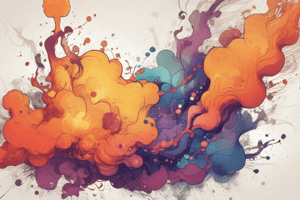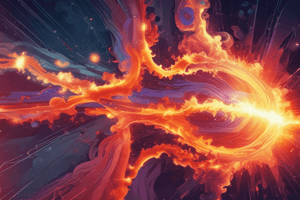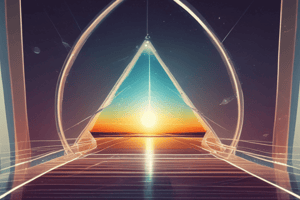Podcast
Questions and Answers
Thomas Edison is often credited with inventing the light bulb, but what contribution did other notable figures make to this technology?
Thomas Edison is often credited with inventing the light bulb, but what contribution did other notable figures make to this technology?
- They solely developed electric batteries, which Edison then used.
- They improved the vacuum technology needed for early light bulbs.
- They are recognized for their electric batteries along with the first incandescent bulbs. (correct)
- They created the neon signs, enabling Edison to focus on the light bulb.
What distinguishes natural light from man-made light?
What distinguishes natural light from man-made light?
- Natural light is generated naturally, while man-made light requires an energy source. (correct)
- Natural light consists of all colors, whereas man-made light is a single color.
- Natural light is only produced by the sun, while man-made light comes from other sources.
- Natural light requires a continuous energy source, whereas man-made light does not.
Which of the following is an example of bioluminescence?
Which of the following is an example of bioluminescence?
- The light from a television screen.
- The light produced by a candle flame.
- The glow of fireflies. (correct)
- The light emitted during a lightning storm.
Why does light change direction when it moves from air into water?
Why does light change direction when it moves from air into water?
What creates an image in a mirror?
What creates an image in a mirror?
How does a transparent object interact with light?
How does a transparent object interact with light?
Which of the following best describes an opaque object's interaction with light?
Which of the following best describes an opaque object's interaction with light?
Why does a banana appear yellow?
Why does a banana appear yellow?
What is the role of a prism in relation to white light?
What is the role of a prism in relation to white light?
Based on the properties of light, how do neon signs produce light of different colors?
Based on the properties of light, how do neon signs produce light of different colors?
Flashcards
Natural Light
Natural Light
Light generated naturally, such as the sun.
Man-made Light
Man-made Light
Light produced by human technology, needing an energy source like electricity or batteries.
Refraction
Refraction
The change in direction of light as it passes from one medium (like air) to another (like water).
Image
Image
Signup and view all the flashcards
Transparent
Transparent
Signup and view all the flashcards
Translucent
Translucent
Signup and view all the flashcards
Opaque
Opaque
Signup and view all the flashcards
Bioluminescence
Bioluminescence
Signup and view all the flashcards
White light
White light
Signup and view all the flashcards
Study Notes
- Light is essential for everyday life.
- Thomas Edison receives credit for inventing the lightbulb; many others contributed to its development.
- Various sources provide light.
Natural Light
- Natural light is light generated naturally.
- The most common source of natural light on Earth is the Sun.
- Natural sources of light include stars, fire, and electricity in storms.
- Bioluminescence is when some animals and plants create their own light, such as fireflies, jellyfish, and mushrooms.
Man-Made Light
- Most man-made lights need an energy source, such as electricity or batteries, to produce light.
- Flashlights, table lamps, neon signs, and televisions are some sources of artificial light.
Refraction
- Light slows down and changes direction when it travels from air into the water.
- Refraction is the change of direction when light passes from one substance into another.
Mirrors and Images
- An image is a picture of the light source that light makes when it bounces off a shiny surface, for instance, a mirror.
Transparent, Translucent and Opaque Objects
- Transparent objects allow most light to pass through them.
- Translucent objects blur light as it passes through them.
- Opaque objects allow little to no light to pass through them.
Colors
- White light consists of the ROYGBIV colors.
- A prism, a cut of clear glass or plastic in a triangular form, can separate white light.
Studying That Suits You
Use AI to generate personalized quizzes and flashcards to suit your learning preferences.




